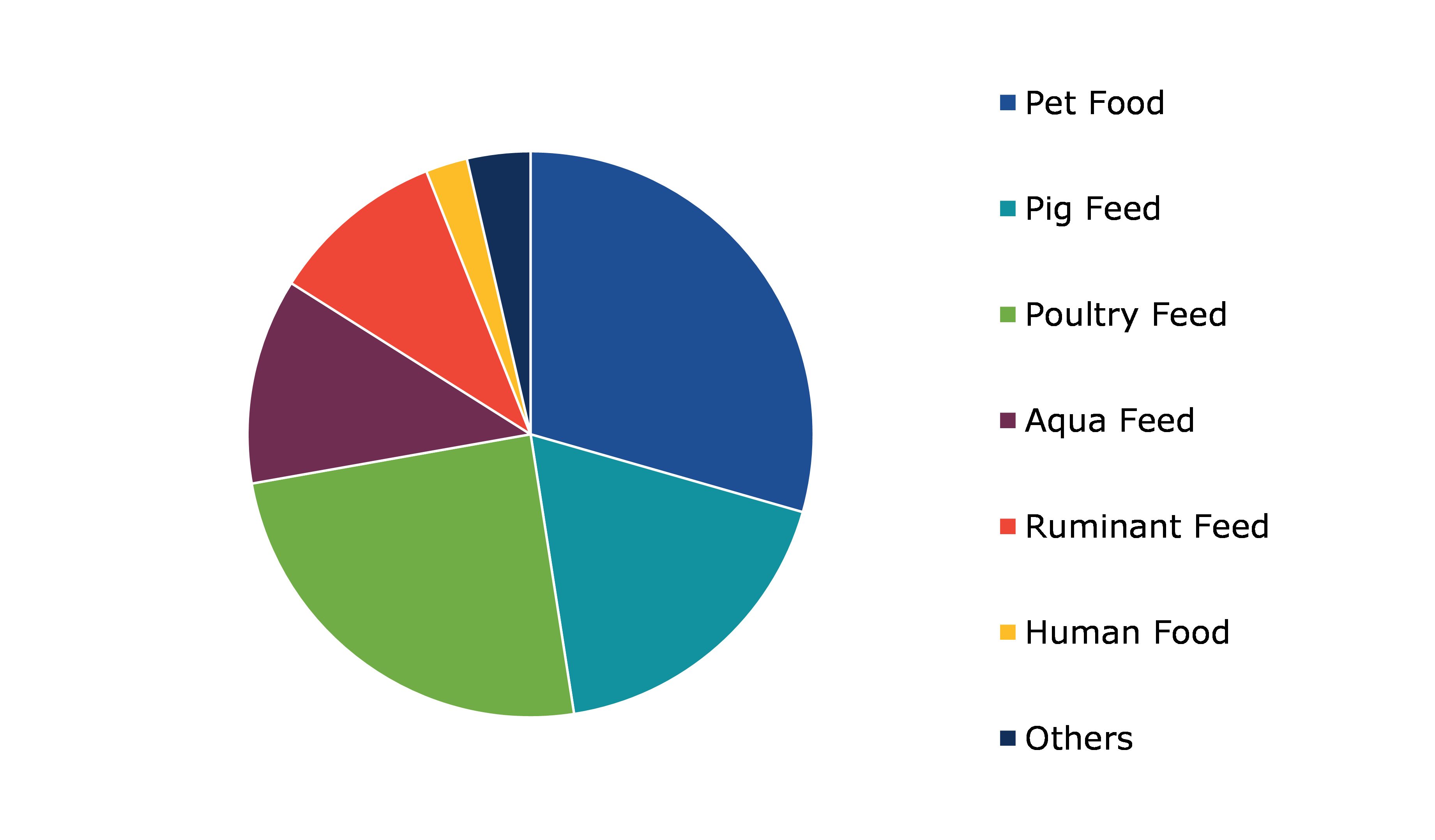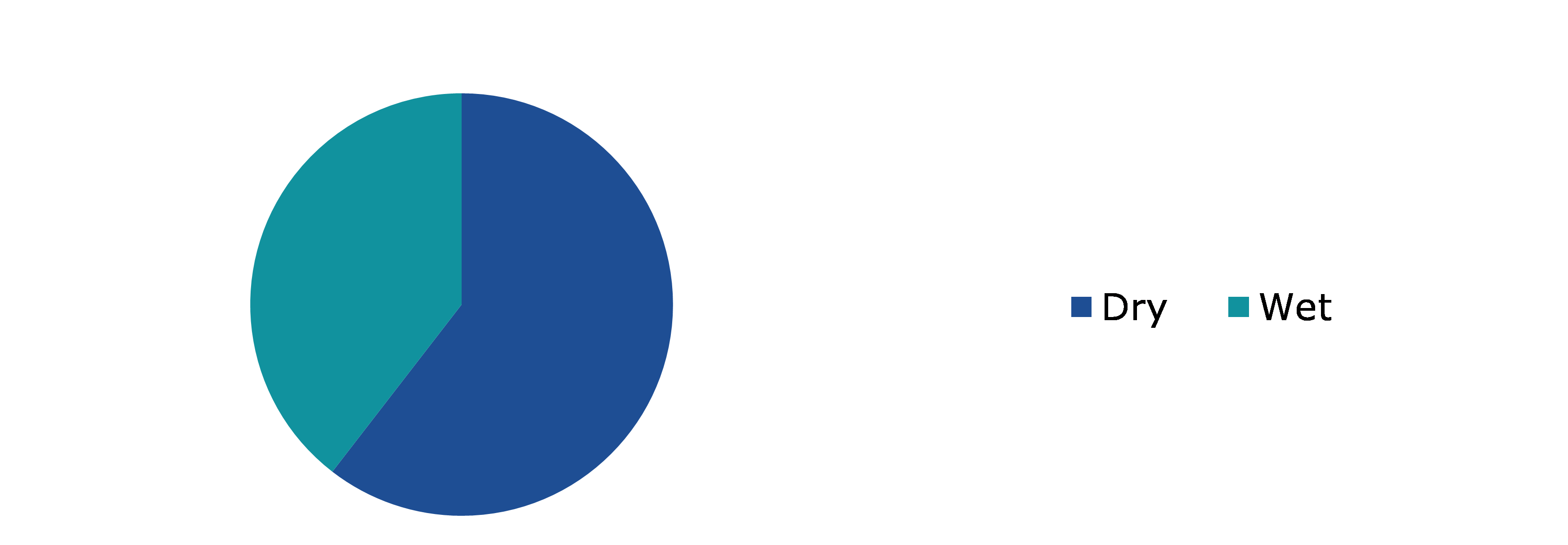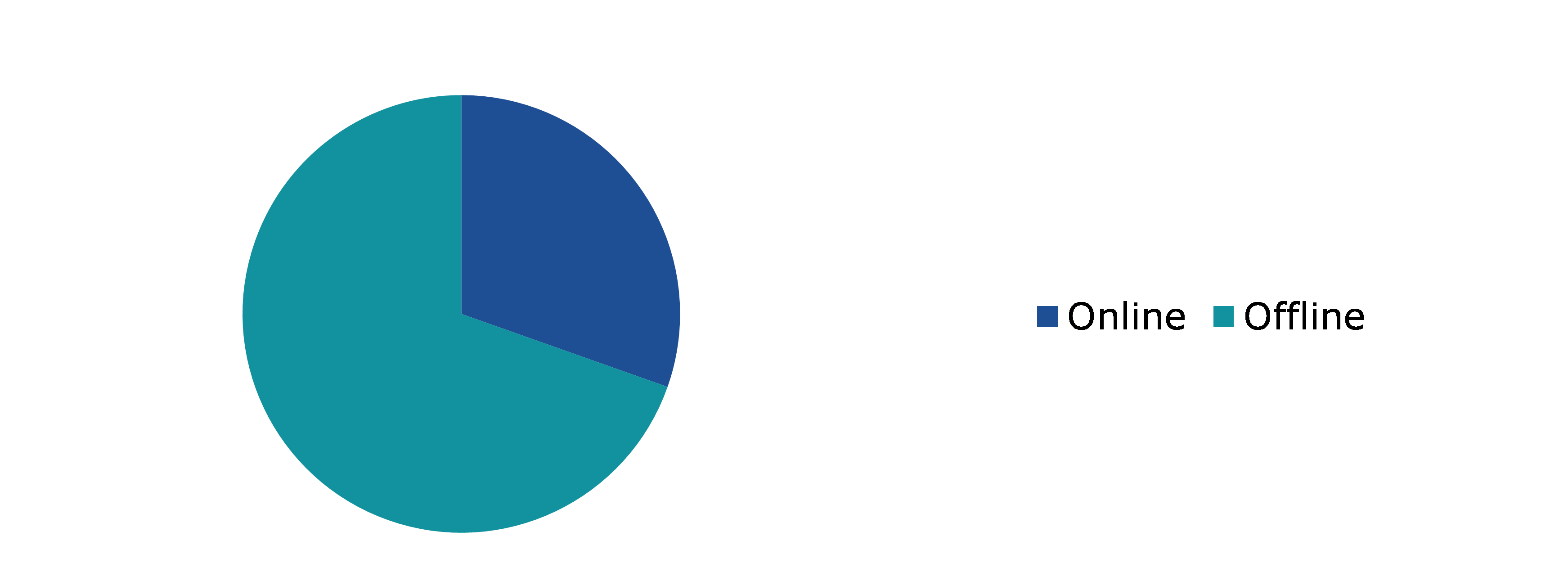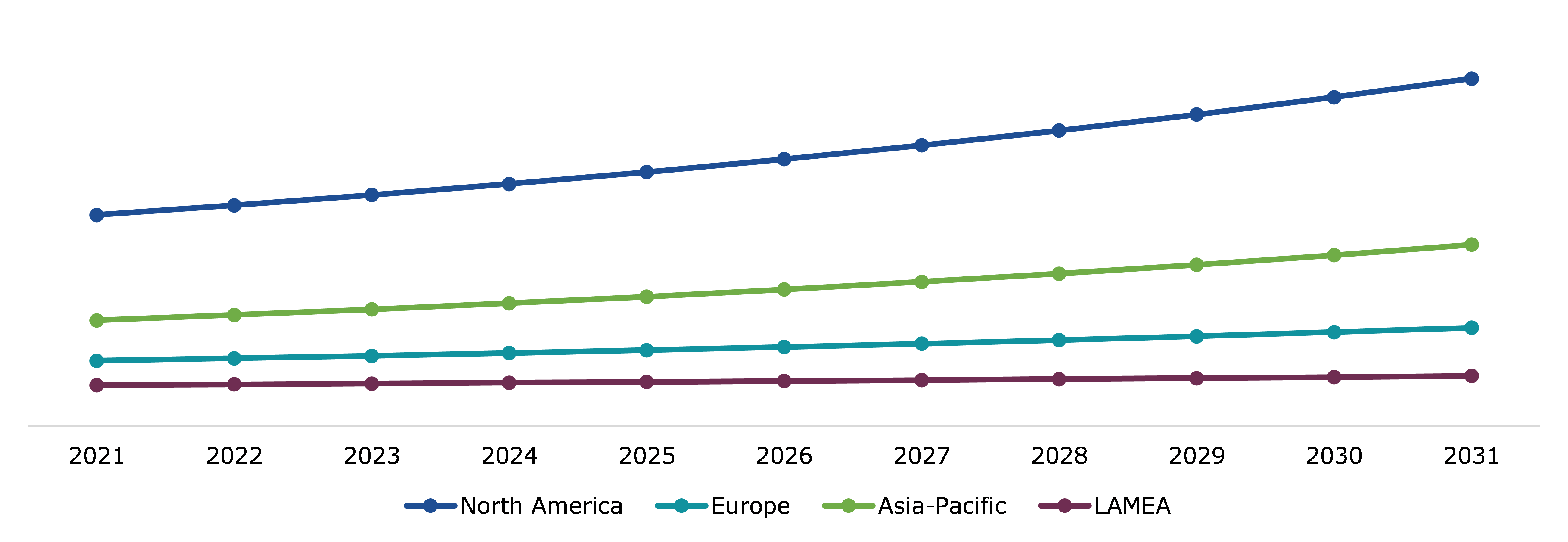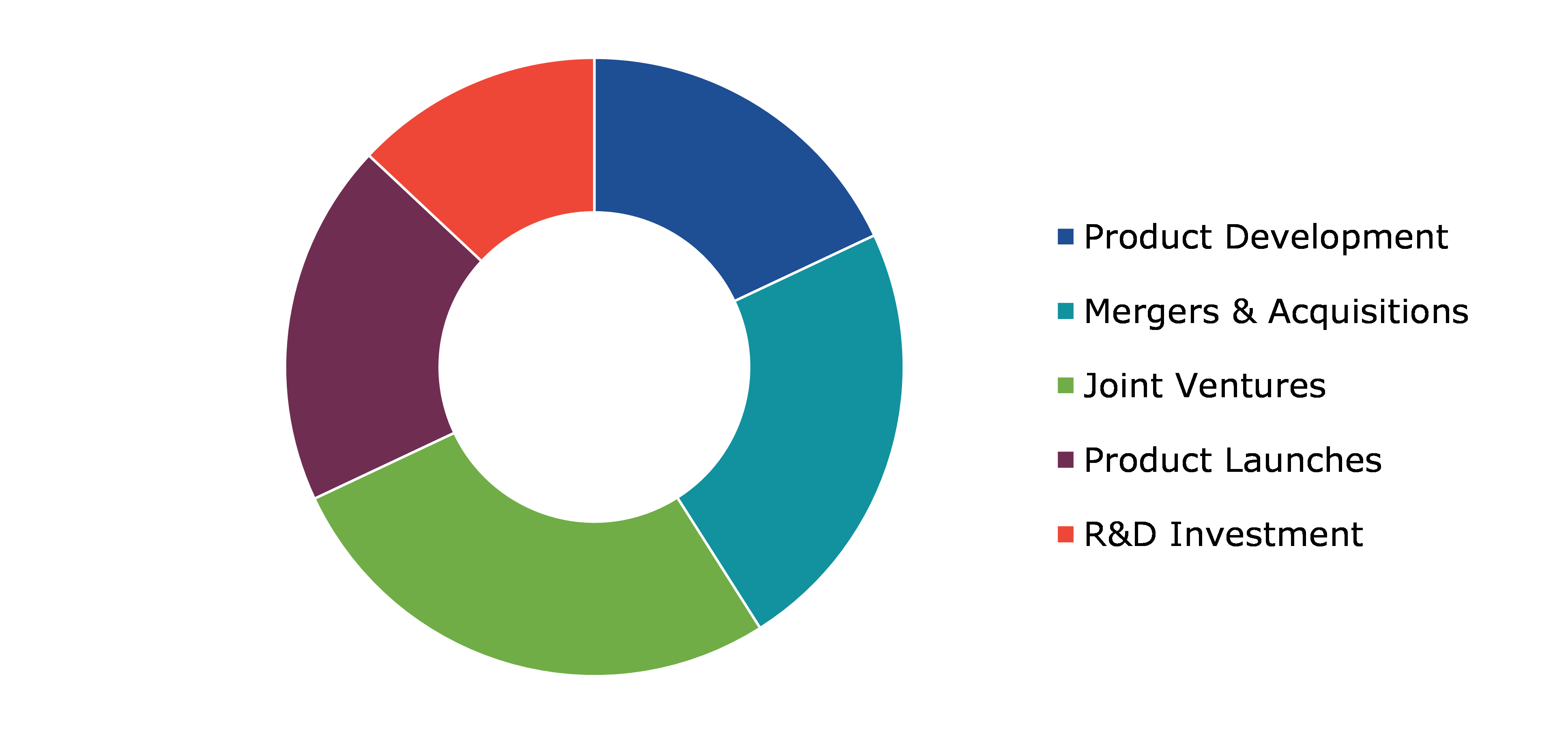Plasma Powder Market Report
RA08642
Plasma Powder Market by Application (Pet Food (Dog and Cat), Pig Feed, Poultry Feed, Aqua Feed (Fish and Shrimp), Ruminant Feed, Human Food, and Others), Source (Porcine, Bovine, Ovine, and Others), Form (Dry and Wet), Sales Channel (Online and Offline), and Regional Analysis (North America, Europe, Asia-Pacific, and LAMEA): Global Opportunity Analysis and Industry Forecast, 2022-2031
Global Plasma Powder Market Analysis
The Global Plasma Powder Market Size was $2,651.3 million in 2021 and is predicted to grow with a CAGR of 4.9%, by generating a revenue of $4,249.2 million by 2031.
Global Plasma Powder Market Synopsis
Plasma powder is a highly digestible type of animal protein used to increase feed palatability and gut health. Spray-dried plasma powder is a natural source of bioactive components that may be used instead of prophylactic antibiotics and zinc oxide in the feed. Plasma powder improves the quality of each formula by maintaining a consistent desired texture and improving nutrient content. Plasma powder improves feed palatability and gut health in young animals, resulting in improved overall performance and a lower mortality rate significantly. Plasma powder is considered an in-feed alternative to preventive antibiotics and zinc oxide as it provides passive mucosal immunity against viral and bacterial infections. IgG immunoglobulins and plasma-borne growth factors in plasma powder boost gut maturation and improve the intestinal barrier. These factors are anticipated to boost the plasma powder industry growth in the upcoming years.
However, the production of plasma powder involves high-end equipment and advanced technology, making it quite expensive. Furthermore, the cost of the raw materials namely porcine, bovine, or ovine blood used for plasma powder production is also quite high, which further increases the cost of production. This results in a limited number of players in the market, reducing the competition and increasing the overall cost of the plasma powder. In addition, the involvement of local and regional level plasma powder producers operating across unorganized markets develop products with low or no standard protocols. Also, there is a high chance of duplication of trade patents products across such an unorganized market creating a significant limitation for the global plasma powder market.
The market is seeing the deployment of advanced technological innovations such as spray-dried porcine plasma, an abattoir by-product used in animal nutrition that has been shown to benefit animals. Spray-dried porcine plasma has a higher nutritional value because it includes highly digestible protein with an optimum profile of amino acids. Spray-dried animal plasma (AP) is commonly utilized in the production of post-weaning meals for animals to increase development and well-being. Major players in porcine plasma feed are focusing on offering cutting-edge innovation to improve their market position, which is predicted to create growth opportunities for the plasma powder market in the coming years.
According to regional analysis, the North America plasma powder market accounted for the highest market share in 2021. The presence of major manufacturers operating in this market and rise in the number of pet owners in the region are factors projected to boost demand for pet food. The pet market is witnessing exponential growth in this region owing to the rise in popularity of pet-loving lifestyles and other factors.
Plasma Powder Overview
Plasma powder is a protein-based binder of high quality that promotes good nutrition while boosting palatability. As compared to other protein sources, this is a great source of necessary amino acids. It also has health benefits such as improved survival rate, greater growth performance, and improved gut health. The penetration of plasma powder is scaling up owing to the rising e-commerce industry wherein pet food and care products are sold. The major players are promoting their products through online channels and investing heavily in promoting the products across social platforms.
COVID-19 Impact on Global Plasma Powder Market
The COVID-19 pandemic has brought several uncertainties leading to severe economic losses as various businesses across the world were standstill. The COVID-19 pandemic has had a significant impact on the plasma powder market. Furthermore, the rigorous regulatory framework for animal-based protein in animal feed is projected to have a significant impact on plasma synthesis. The shuttering of factories and production facilities due to lockdown measures also caused disruptions in the supply chain and led to supply shortages.
Growing use of Bovine-Source Blood Plasma as a Functional Ingredient in Food Processing to Drive the Plasma Powder Market Growth
Bovine plasma is used in the food processing sector as an emulsifier and fat replacement. The use of bovine plasma is scaling up owing to its health promoting properties mainly its high digestibility index as well as functional and palatable ingredients. reducing the loss of a valuable protein source, resulting in greater earnings and environmental advantages that will support the market growth. Bovine plasma is widely used in cattle feed products as it includes protein and promotes intestinal function in young calves. Bovine plasma powder is in high demand because of its multiple advantages, which include improved fecal score, lesser dehydration, reduced mortality, higher grain, and fewer scour days. The growing need for high-quality animal feed premix products that support strong and healthy growth in young animals is anticipated to drive the demand for plasma powder during the forecast period.
To know more about global plasma powder market drivers, get in touch with our analysts here.
Growing Availability of Alternatives at Lower Costs and Lack of Knowledge about Plasma Powder to Restrain the Market Growth
The availability of alternatives at significantly cheaper costs, as well as a lack of information among agricultural communities in developing and developing nations, is projected to be an important impediment to the worldwide expansion of the plasma powder market during the forecast period. The plasma powder undergoes multiple processes that involve melting, cooling, and grinding and any errors committed throughout these stages might have a severe influence on the end product's quality. This is also one of the major factors anticipated to restrain the plasma powder market demand during the forecast period.
Use of Plasma Powder as an Animal-based Protein Source to Drive Excellent Opportunities in the Market
Increase in strain on the livestock business has exacerbated the rise in demand for meat and high-value animal protein. Global livestock consumption has increased owing to population expansion and growing affluence in emerging countries. The market is projected to benefit greatly due to an increase in pet humanization. Growing customer demand for high-nutritional-value pet food stimulates manufacturing companies’ development. Furthermore, the rise in pet adoption and growing concern for pet health has led to an increase in demand for pet feed, which is predicted to create growth opportunities for the plasma powder market players.
To know more about global plasma powder market opportunities, get in touch with our analysts here.
Global Plasma Powder Market, by Application
Based on application, the market has been divided into pet food (dog and cat), pig feed, poultry feed, aqua feed (fish and shrimp), ruminant feed, human food, and others. Among these, the pet food sub-segment accounted for the highest market share in 2021, whereas the pig feed sub-segment is estimated to show the fastest growth during the forecast period.
Global Plasma Powder Market Size, by Application, 2021
Source: Research Dive Analysis
The pet food sub-segment accounted for a dominant market share in 2021. Plasma powder is a highly digestible type of animal food used to promote feed palatability and intestinal health. Spray-dried plasma powder is a natural source of bioactive components that may be used in place of prophylactic antibiotics and zinc oxide in the feed. High-digestible proteins are becoming more important because undigested proteins in the stomach can negatively impact animal health owing to bacterial fermentation and pathogen invasion. Another trend is a desire to limit the use of antibiotics and zinc oxide as preventative measures in animal feed. These industry health trends are well met by plasma powder.
The pig feed sub-segment is anticipated to show the fastest growth by 2031. Plasma powder is majorly used in piglet starter diets to facilitate profitable weaning. Plasma powder is a popular ingredient in pig feed because it provides essential nutrients, proteins, and antibodies. The market for plasma powder in pig feed has grown in recent years due to the increase in demand for high-quality and nutritious pig feed. Plasma powder is often derived from animal blood plasma and contains a high concentration of immune-boosting antibodies, which can help improve the overall health and immunity of pigs.
Global Plasma Powder Market, by Source
Based on source, the market has been divided into porcine, bovine, ovine, and others. Among these, the porcine sub-segment accounted for the highest revenue share in 2021.
Global Plasma Powder Market Share, by Source, 2021
Source: Research Dive Analysis
The porcine sub-segment accounted for a dominant market share in 2021. Spray-dried porcine plasma (SDPP) is a feed ingredient that contains highly digestible proteins and amino acids as well as considerable levels of functional bioactive components such as immunoglobulins, transferrin, growth factors, peptides, and other biologically active components. It is a great source of vital amino acids and has been shown to outperform other protein sources like skim milk. These factors are anticipated to boost the growth of the porcine sub-segment during the forecast timeframe.
Global Plasma Powder Market, by Form
Based on form, the market has been divided into dry and wet. Among these, the dry sub-segment accounted for the highest revenue share in 2021.
Global Plasma Powder Market Forecast, by Form, 2021
Source: Research Dive Analysis
The dry sub-segment accounted for a dominant market share in 2021. Animal-based spray-dried plasma, for example, is utilized as a binder in pharmaceutical formulations such as tablet formulations. worldwide. The dry plasma provides efficient binding, highly palatable, and digestible content that improves pet health. These factors are anticipated to boost the growth of the dry sub-segment during the forecast timeframe.
Global Plasma Powder Market, by Sales Channel
Based on sales channel, the market has been divided into online and offline. Among these, the offline sub-segment accounted for the highest revenue share in 2021.
Global Plasma Powder Market Analysis, by Sales Channel, 2021
Source: Research Dive Analysis
The offline sub-segment accounted for a dominant market share in 2021. The offline segment of the global plasma powder market is predicted to develop at a faster rate during the forecast period. The offline sales channel in the plasma powder market refers to traditional brick-and-mortar sales methods, as compared to online sales through e-commerce platforms. This channel includes physical stores and direct sales through a sales force. These factors are anticipated to boost the growth of the offline sub-segment during the forecast time.
Global Plasma Powder Market, Regional Insights
The plasma powder market was investigated across North America, Europe, Asia-Pacific, and LAMEA.
Global Plasma Powder Market Size & Forecast, by Region, 2021-2031 ($ Million)
Source: Research Dive Analysis
The Market for Plasma Powder in North America to be the Most Dominant
The North America plasma powder market accounted for the highest market share in 2021. North America is anticipated to arise as a strong market for the product due to the existence of a high number of pet owners in the region, which is expected to boost product demand for pet food applications. The pet market is witnessing exponential development owing to the rise in popularity of pet ownership and pet-loving lifestyles, as well as the advent of Internet purchases, which has a favorable influence on the entire market size. The U.S., which has the majority of the pet population, has experienced a large surge in high-protein pet food sales. The presence of a high number of pet owners in the region, as well as a growing trend among livestock farmers to seek new antimicrobial growth promoter options, will boost growth. In the animal sector, there is an increasing need for spray-dried animal plasma, which is well-acknowledged as a vital function and appealing element. Furthermore, the unique benefits provided by plasma derived from bovine and porcine sources have contributed considerably to the market growth.
Competitive Scenario in the Global Plasma Powder Market
Investment and agreement are common strategies followed by major market players. For instance, Darling Ingredients' Rousselot brand announced the establishment of a new Brazilian innovation lab food sector to enable the best product application. The company is planning to use its new facility to expand its global lab network in order to supply innovative, application, and expertise formulations.
Source: Research Dive Analysis
Some of the leading plasma powder market players are Sonac, ACTIPRO, IQI Petfood, Shenzhen Taier, APC, Feed Stimulants, Otto Chemie Pvt. Ltd., British Aqua Feeds, UAP, and Lican Food.
| Aspect | Particulars |
| Historical Market Estimations | 2020 |
| Base Year for Market Estimation | 2021 |
| Forecast Timeline for Market Projection | 2022-2031 |
| Geographical Scope | North America, Europe, Asia-Pacific, and LAMEA |
| Segmentation by Application
|
|
| Segmentation by Source
|
|
| Segmentation by Form |
|
| Segmentation by Sales Channel |
|
| Key Companies Profiled |
|
Q1. What is the size of the global plasma powder market?
A. The size of the global plasma powder market was over $2,651.3 million in 2021 and is projected to reach $4,249.2 million by 2031.
Q2. Which are the major companies in the plasma powder market?
A. Sonac, ACTIPRO, and IQI Petfood are some of the key players in the global plasma powder market.
Q3. Which region, among others, possesses greater investment opportunities in the future?
A. Asia-Pacific possesses great investment opportunities for investors in the future.
Q4. What will be the growth rate of the Asia-Pacific plasma powder market?
A. Asia-Pacific plasma powder market is anticipated to grow at 5.6% CAGR during the forecast period.
Q5. What are the strategies opted by the leading players in this market?
A. Agreement and investment are the two key strategies opted by the operating companies in this market.
Q6. Which companies are investing more on R&D practices?
A. Shenzhen Taier, Feed Stimulants, and British Aqua Feeds are the companies investing more on R&D activities for developing new products and technologies.
1.Research Methodology
1.1.Desk Research
1.2.Real time insights and validation
1.3.Forecast model
1.4.Assumptions and forecast parameters
1.5.Market size estimation
1.5.1.Top-down approach
1.5.2.Bottom-up approach
2.Report Scope
2.1.Market definition
2.2.Key objectives of the study
2.3.Report overview
2.4.Market segmentation
2.5.Overview of the impact of COVID-19 on Global plasma powder market
3.Executive Summary
4.Market Overview
4.1.Introduction
4.2.Growth impact forces
4.2.1.Drivers
4.2.2.Restraints
4.2.3.Opportunities
4.3.Market value chain analysis
4.3.1.List of providers
4.3.2.List of suppliers
4.3.3.List of distributors
4.4.Innovation & sustainability matrices
4.4.1.Technology matrix
4.4.2.Patent matrix
4.4.3.Regulatory matrix
4.5.Porter’s five forces analysis
4.5.1.Bargaining power of suppliers
4.5.2.Bargaining power of consumers
4.5.3.Threat of substitutes
4.5.4.Threat of new entrants
4.5.5.Competitive rivalry intensity
4.6.PESTLE analysis
4.6.1.Political
4.6.2.Economical
4.6.3.Social
4.6.4.Technological
4.6.5.Environmental
4.7.Impact of COVID-19 on Plasma Powder market
4.7.1.Pre-covid market scenario
4.7.2.Post-covid market scenario
5.Plasma Powder Market Analysis, by Application
5.1.Overview
5.2.Pet Food
5.2.1.Definition, key trends, growth factors, and opportunities
5.2.2.Market size analysis, by region
5.2.3.Market share analysis, by country
5.2.3.1.Dog
5.2.3.1.1.Definition, key trends, growth factors, and opportunities
5.2.3.1.2.Market size analysis, by region
5.2.3.1.3.Market share analysis, by country
5.2.3.2.Cat
5.2.3.2.1.Definition, key trends, growth factors, and opportunities
5.2.3.2.2.Market size analysis, by region
5.2.3.2.3.Market share analysis, by country
5.3.Pig Feed
5.3.1.Definition, key trends, growth factors, and opportunities
5.3.2.Market size analysis, by region
5.3.3.Market share analysis, by country
5.4.Poultry Feed
5.4.1.Definition, key trends, growth factors, and opportunities
5.4.2.Market size analysis, by region
5.4.3.Market share analysis, by country
5.5.Aqua Feed
5.5.1.Definition, key trends, growth factors, and opportunities
5.5.2.Market size analysis, by region
5.5.3.Market share analysis, by country
5.5.3.1.Fish
5.5.3.1.1.Definition, key trends, growth factors, and opportunities
5.5.3.1.2.Market size analysis, by region
5.5.3.1.3.Market share analysis, by country
5.5.3.2.Shrimp
5.5.3.2.1.Definition, key trends, growth factors, and opportunities
5.5.3.2.2.Market size analysis, by region
5.5.3.2.3.Market share analysis, by country
5.6.Ruminant Feed
5.6.1.Definition, key trends, growth factors, and opportunities
5.6.2.Market size analysis, by region
5.6.3.Market share analysis, by country
5.7.Human Food
5.7.1.Definition, key trends, growth factors, and opportunities
5.7.2.Market size analysis, by region
5.7.3.Market share analysis, by country
5.8.Other
5.8.1.Definition, key trends, growth factors, and opportunities
5.8.2.Market size analysis, by region
5.8.3.Market share analysis, by country
5.9.Research Dive Exclusive Insights
5.9.1.Market attractiveness
5.9.2.Competition heatmap
6.Plasma Powder Market Analysis, by Source
6.1.Porcine
6.1.1.Definition, key trends, growth factors, and opportunities
6.1.2.Market size analysis, by region
6.1.3.Market share analysis, by country
6.2.Bovine
6.2.1.Definition, key trends, growth factors, and opportunities
6.2.2.Market size analysis, by region
6.2.3.Market share analysis, by country
6.3.Ovine
6.3.1.Definition, key trends, growth factors, and opportunities
6.3.2.Market size analysis, by region
6.3.3.Market share analysis, by country
6.4.Others
6.4.1.Definition, key trends, growth factors, and opportunities
6.4.2.Market size analysis, by region
6.4.3.Market share analysis, by country
6.5.Research Dive Exclusive Insights
6.5.1.Market attractiveness
6.5.2.Competition heatmap
7.Plasma Powder Market Analysis, by Form
7.1.Dry
7.1.1.Definition, key trends, growth factors, and opportunities
7.1.2.Market size analysis, by region
7.1.3.Market share analysis, by country
7.2.Wet
7.2.1.Definition, key trends, growth factors, and opportunities
7.2.2.Market size analysis, by region
7.2.3.Market share analysis, by country
7.3.Research Dive Exclusive Insights
7.3.1.Market attractiveness
7.3.2.Competition heatmap
8.Plasma Powder Market Analysis, by Sales Channel
8.1.Online
8.1.1.Definition, key trends, growth factors, and opportunities
8.1.2.Market size analysis, by region
8.1.3.Market share analysis, by country
8.2.Offline
8.2.1.Definition, key trends, growth factors, and opportunities
8.2.2.Market size analysis, by region
8.2.3.Market share analysis, by country
8.3.Research Dive Exclusive Insights
8.3.1.Market attractiveness
8.3.2.Competition heatmap
9.Plasma Powder Market, by region
9.1.North America
9.1.1.U.S.
9.1.1.1.Market size analysis, by Application
9.1.1.2.Market size analysis, by Source
9.1.1.3.Market size analysis, by Form
9.1.1.4.Market size analysis, by Sales Channel
9.1.2.Canada
9.1.2.1.Market size analysis, by Application
9.1.2.2.Market size analysis, by Source
9.1.2.3.Market size analysis, by Form
9.1.2.4.Market size analysis, by Sales Channel
9.1.3.Mexico
9.1.3.1.Market size analysis, by Application
9.1.3.2.Market size analysis, by Source
9.1.3.3.Market size analysis, by Form
9.1.3.4.Market size analysis, by Sales Channel
9.1.4.Research Dive Exclusive Insights
9.1.4.1.Market attractiveness
9.1.4.2.Competition heatmap
9.2.Europe
9.2.1.Germany
9.2.1.1.Market size analysis, by Application
9.2.1.2.Market size analysis, by Source
9.2.1.3.Market size analysis, by Form
9.2.1.4.Market size analysis, by Sales Channel
9.2.2.UK
9.2.2.1.Market size analysis, by Application
9.2.2.2.Market size analysis, by Source
9.2.2.3.Market size analysis, by Form
9.2.2.4.Market size analysis, by Sales Channel
9.2.3.France
9.2.3.1.Market size analysis, by Application
9.2.3.2.Market size analysis, by Source
9.2.3.3.Market size analysis, by Form
9.2.3.4.Market size analysis, by Sales Channel
9.2.4.Spain
9.2.4.1.Market size analysis, by Application
9.2.4.2.Market size analysis, by Source
9.2.4.3.Market size analysis, by Form
9.2.4.4.Market size analysis, by Sales Channel
9.2.5.Italy
9.2.5.1.Market size analysis, by Application
9.2.5.2.Market size analysis, by Source
9.2.5.3.Market size analysis, by Form
9.2.5.4.Market size analysis, by Sales Channel
9.2.6.Rest of Europe
9.2.6.1.Market size analysis, by Application
9.2.6.2.Market size analysis, by Source
9.2.6.3.Market size analysis, by Form
9.2.6.4.Market size analysis, by Sales Channel
9.2.7.Research Dive Exclusive Insights
9.2.7.1.Market attractiveness
9.2.7.2.Competition heatmap
9.3.Asia-Pacific
9.3.1.China
9.3.1.1.Market size analysis, by Application
9.3.1.2.Market size analysis, by Source
9.3.1.3.Market size analysis, by Form
9.3.1.4.Market size analysis, by Sales Channel
9.3.2.Japan
9.3.2.1.Market size analysis, by Application
9.3.2.2.Market size analysis, by Source
9.3.2.3.Market size analysis, by Form
9.3.2.4.Market size analysis, by Sales Channel
9.3.3.India
9.3.3.1.Market size analysis, by Application
9.3.3.2.Market size analysis, by Source
9.3.3.3.Market size analysis, by Form
9.3.3.4.Market size analysis, by Sales Channel
9.3.4.Australia
9.3.4.1.Market size analysis, by Application
9.3.4.2.Market size analysis, by Source
9.3.4.3.Market size analysis, by Form
9.3.4.4.Market size analysis, by Sales Channel
9.3.5.South Korea
9.3.5.1.Market size analysis, by Application
9.3.5.2.Market size analysis, by Source
9.3.5.3.Market size analysis, by Form
9.3.5.4.Market size analysis, by Sales Channel
9.3.6.Rest of Asia-Pacific
9.3.6.1.Market size analysis, by Application
9.3.6.2.Market size analysis, by Source
9.3.6.3.Market size analysis, by Form
9.3.6.4.Market size analysis, by Sales Channel
9.3.7.Research Dive Exclusive Insights
9.3.7.1.Market attractiveness
9.3.7.2.Competition heatmap
9.4.LAMEA
9.4.1.Brazil
9.4.1.1.Market size analysis, by Application
9.4.1.2.Market size analysis, by Source
9.4.1.3.Market size analysis, by Form
9.4.1.4.Market size analysis, by Sales Channel
9.4.2.Saudi Arabia
9.4.2.1.Market size analysis, by Application
9.4.2.2.Market size analysis, by Source
9.4.2.3.Market size analysis, by Form
9.4.2.4.Market size analysis, by Sales Channel
9.4.3.UAE
9.4.3.1.Market size analysis, by Application
9.4.3.2.Market size analysis, by Source
9.4.3.3.Market size analysis, by Form
9.4.3.4.Market size analysis, by Sales Channel
9.4.4.South Africa
9.4.4.1.Market size analysis, by Application
9.4.4.2.Market size analysis, by Source
9.4.4.3.Market size analysis, by Form
9.4.4.4.Market size analysis, by Sales Channel
9.4.5.Rest of LAMEA
9.4.5.1.Market size analysis, by Application
9.4.5.2.Market size analysis, by Source
9.4.5.3.Market size analysis, by Form
9.4.5.4.Market size analysis, by Sales Channel
9.4.6.Research Dive Exclusive Insights
9.4.6.1.Market attractiveness
9.4.6.2.Competition heatmap
10.Competitive Landscape
10.1.Top winning strategies, 2021
10.1.1.By strategy
10.1.2.By year
10.2.Strategic overview
10.3.Market share analysis, 2021
11.Company Profiles
11.1.Sonac
11.1.1.Overview
11.1.2.Business segments
11.1.3.Product portfolio
11.1.4.Financial performance
11.1.5.Recent developments
11.1.6.SWOT analysis
11.2.ACTIPRO
11.2.1.Overview
11.2.2.Business segments
11.2.3.Product portfolio
11.2.4.Financial performance
11.2.5.Recent developments
11.2.6.SWOT analysis
11.3.IQI Petfood
11.3.1.Overview
11.3.2.Business segments
11.3.3.Product portfolio
11.3.4.Financial performance
11.3.5.Recent developments
11.3.6.SWOT analysis
11.4.Shenzhen Taier
11.4.1.Overview
11.4.2.Business segments
11.4.3.Product portfolio
11.4.4.Financial performance
11.4.5.Recent developments
11.4.6.SWOT analysis
11.5.APC
11.5.1.Overview
11.5.2.Business segments
11.5.3.Product portfolio
11.5.4.Financial performance
11.5.5.Recent developments
11.5.6.SWOT analysis
11.6.FeedStimulants
11.6.1.Overview
11.6.2.Business segments
11.6.3.Product portfolio
11.6.4.Financial performance
11.6.5.Recent developments
11.6.6.SWOT analysis
11.7.Otto Chemie Pvt. Ltd.
11.7.1.Overview
11.7.2.Business segments
11.7.3.Product portfolio
11.7.4.Financial performance
11.7.5.Recent developments
11.7.6.SWOT analysis
11.8.British Aqua Feeds
11.8.1.Overview
11.8.2.Business segments
11.8.3.Product portfolio
11.8.4.Financial performance
11.8.5.Recent developments
11.8.6.SWOT analysis
11.9.UAP
11.9.1.Overview
11.9.2.Business segments
11.9.3.Product portfolio
11.9.4.Financial performance
11.9.5.Recent developments
11.9.6.SWOT analysis
11.10.Lican Food
11.10.1.Overview
11.10.2.Business segments
11.10.3.Product portfolio
11.10.4.Financial performance
11.10.5.Recent developments
11.10.6.SWOT analysis
Plasma powder is a high-protein powder that is derived from blood plasma, and it is widely used as an ingredient in animal feed. It is a rich source of protein, containing over 70% protein on a dry matter basis. This high protein content makes it an ideal ingredient in animal feed, especially for young animals, who require a high-protein diet to support their growth and development. Plasma powder is highly digestible, which means animals can easily absorb and utilize the protein it provides. Moreover, plasm powder also offers immunological benefits for animals. It contains a variety of immune factors, including antibodies, which can help to support the immune system of animals and protect them from diseases. Studies have shown that feeding plasma powder to young animals can improve their immunity and reduce the incidence of diseases. In addition, plasma powder is also highly palatable. This is especially important for young animals who may be picky eaters and require enticing feed to encourage them to eat.
One of the most significant advantages of plasma powder is its versatility in animal nutrition. It can be used in a wide range of animal feeds, including pig, poultry, and aquaculture feeds. It can also be included in both starter and grower feeds, making it a valuable ingredient throughout the animal’s life.
Forecast Analysis of the Global Plasma Powder Market
According to the report published by Research Dive, the global plasma powder market is anticipated to garner a revenue of $4,249.2 million and rise at a CAGR of 4.9% throughout the analysis timeframe from 2022 to 2031.
The growing use of bovine-source blood plasma as functional and palatable ingredients in the food processing sector is expected to propel the growth of the global plasma powder market over the estimated timeframe. Besides, the increasing need for high-quality animal feed premix products that support strong and healthy growth in young animals is predicted to bolster the growth of the market over the estimated period. Moreover, the rising use of plasma powder as an animal-based protein source is predicted to create wide growth opportunities for the plasma powder market over the estimated period. However, the growing availability of alternatives at lower costs and the lack of knowledge about plasma powder may hinder the growth of the market over the analysis timeframe.
The major players of the plasma powder market include Feed Stimulants, Otto Chemie Pvt. Ltd., APC, British Aqua Feeds, Shenzhen Taier, UAP, IQI Petfood, ACTIPRO, Lican Food, Sonac, and many more.
Key Developments of the Market
The key companies operating in the industry are adopting various growth strategies & business tactics such as partnerships, collaborations, mergers & acquisitions, and launches to maintain a robust position in the overall market, which is subsequently helping the global plasma powder market to grow exponentially. For instance:
- In May 2021, Darling Ingredients' Rousselot® brand, the leading organization turning edible by-products and food waste into sustainable products announced to reopen of its Brazilian innovation lab to serve the increasing need for in-class application across the food and nutrition, and pharmaceutical markets. This would strengthen its lab network across the globe.
- In May 2022, Darling Ingredients Inc., a well-established company turning food waste into sustainable products announced its acquisition of Valley Proteins, a leading company that recycles and renders animal by-products. With this acquisition, Darling Ingredients aimed to focus on strengthening its business and providing additional low low-carbon intensity feedstocks.
- In November 2022, IQI Trusted Petfood Ingredients, a worldwide provider of premium claim ingredients to the top brands in the pet food industry announced its partnership with Houdek, a leading manufacturer of ME-PRO® plant-based protein for the aqua feed industry. With this partnership, the companies aimed to develop plant-based protein specifically for the pet food industry with healthy and sustainable plant-based ingredients.
Most Profitable Region
The North America region of the plasma powder market generated the highest revenue in 2021 and is expected to continue steady growth over the analysis period. This is mainly due to the presence of a high number of pet owners in the region. Moreover, the rising popularity of pet ownership and pet-loving lifestyle across the region is expected to boost the regional growth of the market during the estimated period.
Covid-19 Impact on the Plasma Powder Market
The outbreak of the Covid-19 pandemic has caused severe economic losses and brought various uncertainties across various industries. It has badly impacted the plasma powder market. This is majorly due to the shutting down of factories and production facilities due to the imposed lockdowns by governments of many nations. Moreover, the disruption in supply chains and the regulatory framework for animal-based protein in animal feed have declined the growth of the market throughout the crisis.
Personalize this research
- Triangulate with your own data
- Request your format and definition
- Get a deeper dive on a specific application, geography, customer or competitor
- + 1-888-961-4454 Toll - Free
- support@researchdive.com


